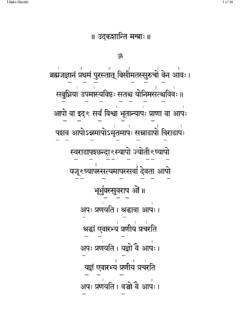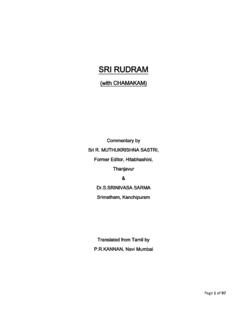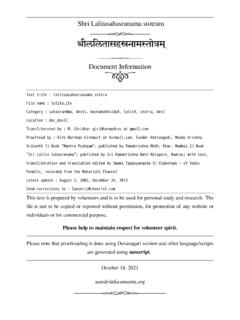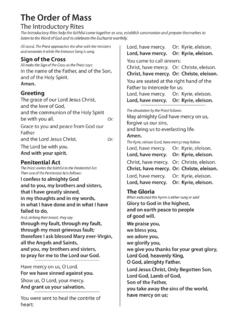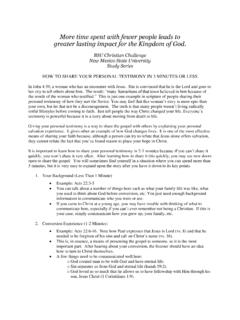Transcription of HINDU RITUALS AND ROUTINES - WHY DO WE FOLLOW …
1 HINDU RITUALS AND ROUTINES - why do WE FOLLOW THOSE? Contents 1. why do we light a lamp? .. 2 2. why do we have a prayer room? .. 3 3. why do we do Namaste? .. 4 4. why do we prostrate before parents and elders? .. 5 5. why do we wear marks (tilak, pottu and the like) on the forehead? .. 6 6. why do we not touch papers, books and people with the feet? .. 7 7. To touch another with the feet is considered an act of misdemeanor. Why is this so?.. 7 8. why do we apply the holy ash? .. 8 9. why do offer food to the Lord before eating it? .. 9 10. why do we fast?
2 10 11. why do we do pradakshina (circumambulate)? .. 11 12. Why is pradakshina done only in a clockwise manner?.. 11 13. why do we regard trees and plants as sacred?.. 11 14. why do we ring the bell in a temple? .. 12 15. why do we worship the kalasha? .. 13 16. why do we consider the lotus as special? .. 14 17. why do we worship tulasi? .. 15 18. why do we blow the conch?.. 16 19. why do we say shaanti thrice? .. 17 20. why do we offer a coconut? .. 18 21. why do we chant Om? .. 19 22. why do we do aarati? .. 20 1. why do we light a lamp?
3 In almost every Indian home a lamp is lit daily before the altar of the Lord. In some houses it is lit at dawn, in some, twice a day at dawn and dusk and in a few it is maintained continuously (Akhanda Deepa). All auspicious functions commence with the lighting of the lamp, which is often maintained right through the occasion. Light symbolizes knowledge, and darkness, ignorance. The Lord is the "Knowledge Principle" (Chaitanya) who is the source, the enlivener and the illuminator of all knowledge. Hence light is worshiped as the Lord himself.
4 Knowledge removes ignorance just as light removes darkness. Also knowledge is a lasting inner wealth by which all outer achievement can be accomplished. Hence we light the lamp to bow down to knowledge as the greatest of all forms of wealth. Why not light a bulb or tube light? That too would remove darkness. But the traditional oil lamp has a further spiritual significance. The oil or ghee in the lamp symbolizes our vaasanas or negative tendencies and the wick, the ego. When lit by spiritual knowledge, the vaasanas get slowly exhausted and the ego too finally perishes.
5 The flame of a lamp always burns upwards. Similarly we should acquire such knowledge as to take us towards higher ideals. Whilst lighting the lamp we thus pray: Deepajyothi parabrahma Deepa sarva tamopahaha Deepena saadhyate saram Sandhyaa deepo namostute I prostrate to the dawn/dusk lamp; whose light is the Knowledge Principle (the Supreme Lord), which removes the darkness of ignorance and by which all can be achieved in life. 2. why do we have a prayer room? Most Indian homes have a prayer room or altar. A lamp is lit and the Lord worshipped each day.
6 Other spiritual practices like japa (repetition of the Lord s name), meditation, paaraayana (reading of the scriptures), prayers, and devotional singing etc is also done here. Special worship is done on auspicious occasions like birthdays, anniversaries, festivals and the like. Each member of the family - young or old - communes with and worships the Divine here. The Lord is the entire creation. He is therefore the true owner of the house we live in too. The prayer room is the Master room of the house. We are the earthly occupants of His property.
7 This notion rids us of false pride and possessiveness. The ideal attitude to take is to regard the Lord as the true owner of our homes and us as caretakers of His home. But if that is rather difficult, we could at least think of Him as a very welcome guest. Just as we would house an important guest in the best comfort, so too we felicitate the Lord s presence in our homes by having a prayer room or altar, which is, at all times, kept clean and well-decorated. Also the Lord is all pervading. To remind us that He resides in our homes with us, we have prayer rooms.
8 Without the grace of the Lord, no task can be successfully or easily accomplished. We invoke His grace by communing with Him in the prayer room each day and on special occasions. Each room in a house is dedicated to a specific function like the bedroom for resting, the drawing room to receive guests, the kitchen for cooking etc. The furniture, decor and the atmosphere of each room are made conducive to the purpose it serves. So too for the purpose of meditation, worship and prayer, we should have a conducive atmosphere - hence the need for a prayer room.
9 Sacred thoughts and sound vibrations pervade the place and influence the minds of those who spend time there. Spiritual thoughts and vibrations accumulated through regular meditation, worship and chanting done there pervade the prayer room. Even when we are tired or agitated, by just sitting in the prayer room for a while, we feel calm, rejuvenated and spiritually uplifted. 3. why do we do Namaste? Indians greet each other with namaste. The two palms are placed together in front of the chest and the head bows whilst saying the word namaste.
10 This greeting is for all - people younger than us, of our own age, those older than friends, even strangers and us. There are five forms of formal traditional greeting enjoined in the shaastras of which namaskaram is one. This is understood as prostration but it actually refers to paying homage as we do today when we greet each other with a namaste. Namaste could be just a casual or formal greeting, a cultural convention or an act of worship. However there is much more to it than meets the eye. In Sanskrit namah + te = namaste.
